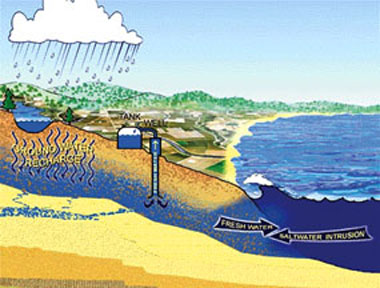|
Geo Factos
Groundwater
The hidden resource
 The
importance of water is immense, and no one needs to exaggerate (make
something seem bigger) on this since we all know how it sustains the
existence of Earth and its living beings. The
importance of water is immense, and no one needs to exaggerate (make
something seem bigger) on this since we all know how it sustains the
existence of Earth and its living beings.
Water becomes extremely significant because although 98 per cent of
the globe is covered in water in the form of oceans, only about two per
cent of the planet's water is fresh. Out of this ,1.6 per cent is locked
up in the polar ice caps and glaciers.
Another 0.36 per cent is found underground. Only about 0.036 per cent
of the planet's total water supply is found in lakes and rivers. Today
let's look at the 0.36 per cent which exist as groundwater.
Groundwater, aquifers and the water table
Simply put, groundwater is the water that is trapped below the
Earth's surface. That being the general description, three other terms
can be introduced which resemble the amount of water below the Earth's
surface.
The first is 'aquifer'. An aquifer is a water deposit made of
permeable (ability to flow into all parts) rock or other loose material
which contains a sufficient amount of water. The wells in your homes
generally tap water from aquifers. Aquifers can be spread over an extent
ranging from a few acres to thousands of square kilometres, and they can
also have a thickness ranging from a few metres to few hundreds of
metres.
The next term associated with groundwater is 'water table'. This
involves a higher quantity of water compared to an aquifer.
When the soil pores or other loose material below the surface get
completely saturated (full) with water, such a region is called a water
table.
The region above the water table is known as the 'unsaturated zone'
which has some water as in aquifers, but not saturated.
Groundwater has a cycle. The water seeps throughout the surface in to
the underground. This is known as 'recharge'.
However, eventually, groundwater will 'discharge' at springs,
wetlands and oases. This process is known as the 'water cycle'
associated with groundwater.
The duration of this cycle can vary from a few days to thousands of
years.
Sri Lanka’s groundwater
 Groundwater
has been utilised for a range of purposes in Sri Lanka ever since the
time of our ancestors. Until the recent past, more than 95 per cent of
the groundwater utilisation of the country was for agricultural
purposes. The rest was shared between industrial applications and other
activities. Groundwater
has been utilised for a range of purposes in Sri Lanka ever since the
time of our ancestors. Until the recent past, more than 95 per cent of
the groundwater utilisation of the country was for agricultural
purposes. The rest was shared between industrial applications and other
activities.
However, like many other resources, there is a necessity for
conserving this resource, and many management strategies are under way
with this objective in mind.
Current problems
Several problems that have come to notice globally, which require
effective strategies for groundwater management, are seen in Sri Lanka
as well.
The intense pumping of groundwater for agricultural activities has
started to lower the water table and consequently, a requirement has
arisen to increase the depth of wells.
In addition, farmers in the dry zone complain about the lack of
groundwater, mainly because over-pumping has dried off aquifers. With
more agro-wells tapping into the same limited resource, and more
intensive agriculture taking place, it is likely to mean that shallow
groundwater resources will become further depleted and more severely
polluted.
In some areas, like the Kalpitiya peninsula, high concentrations of
nitrates and agrochemicals are already being found in groundwater.
Several deep tube-wells constructed recently to provide drinking water
in the dry zone have been abandoned because of high iron and fluoride
concentrations.
 The
coastal sand aquifer which feeds the Kalpitiya peninsula, which is
popular for its intensive groundwater-based vegetable production, is
experiencing a gradual build-up of salt and agrochemicals. The
coastal sand aquifer which feeds the Kalpitiya peninsula, which is
popular for its intensive groundwater-based vegetable production, is
experiencing a gradual build-up of salt and agrochemicals.
Similarly, in Batticaloa, salinity (salt content) and nitrate
pollution is affecting agro-wells and the nitrate levels found were
three to five times higher than the recommended limit set by the World
Health Organisation.
This becomes prominent since the aquifers in Sri Lanka are situated
in a very shallow level. This directly affects rural drinking water
since 80 per cent of the requirement is satisfied by open dug wells.
The tsunami and groundwater
The tsunami which struck Sri Lanka in 2004 had a direct impact on the
coastal groundwater, mainly on the aquifers. The flooding waves of the
tsunami caused millions of gallons of sea water to enter the underground
reservoirs through open wells.
The salty waters had infiltrated (sunk) through the permeable sands
that are typical of coastal aquifers. It was reported that over 40,000
drinking water wells were either destroyed or contaminated.
This infiltration of seawater had caused the salinity levels of
groundwater to increase. Extensive pumping has been done in order to
remove the saline water from the wells, but the salinity levels were
expected to drop only after a few monsoons which would result in
recharge of groundwater. |
